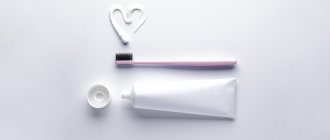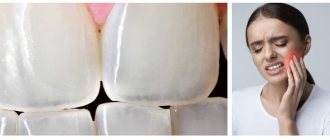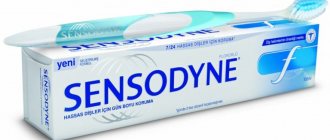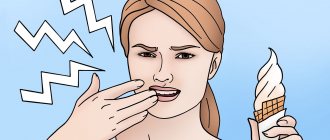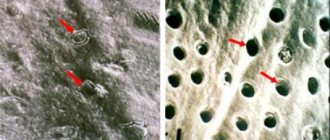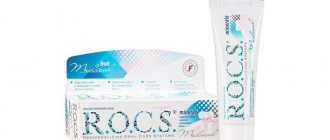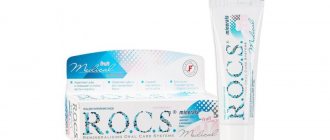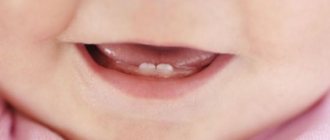- Treatment at the dentist's office
- The principle of operation of toothpastes for sensitive teeth
- Active substances in pastes
- Which desensitization paste to choose for a child?
- Examples of pastes for daily use
Increased sensitivity of teeth, medically known as hyperesthesia, is a disease that is familiar to every second adult.
The main manifestation is a painful reaction to hot or cold, sour or sweet foods, chewing, or brushing teeth. Enamel is the hardest tissue in the body, but even it is vulnerable to acidic and aggressive mechanical influences. In areas where the enamel becomes thinner, substances from outside enter the dentin, or more precisely, into the dentinal tubules. They contain many nerve endings that react to the stimulus.
Increased sensitivity of teeth is not a disease in the usual sense, but a symptom that can be caused by various reasons.
- Recent systemic
illnesses. - Dental
diseases. - Deficiency
of vital vitamins and microelements in the body due to an unbalanced diet. - Using toothbrushes with hard bristles
and abrasive toothpastes. - Habit of biting nails
or clenching teeth. - Poor
oral hygiene. - Recent in-office whitening
.
Depending on the cause, the way to deal with hypersensitivity will be different. How to reduce tooth sensitivity or prevent it - we tell you in this article.
Treatment at the dentist's office
To determine the clinical situation and causes of sensitivity, we recommend that you consult a dentist. The doctor will be able to prescribe procedures that are effective for your case.
- Fluoridation and remotherapy
- they strengthen the enamel, saturate the hard tissues of the tooth with useful elements and help reduce sensitivity. - Electrophoresis
- it improves the susceptibility of hard tissues to beneficial substances of fluorinated and remineralizing compounds. - Treatment of caries and filling
.
To maintain the effect of the procedures, the dentist may recommend enamel-strengthening products for home use - daily pastes, gels and rinses.
Treatment methods
First of all, eliminating dental hypersensitivity is aimed at treating the underlying disease. The treatment program is selected by the dentist depending on the clinical picture.
First, caries and periodontal diseases are treated. After this, the doctor will perform additional procedures aimed at strengthening the enamel:
- Coating the crown with fluoride-containing compounds.
- Sealing of enamel using special composite materials.
If necessary, the doctor will prescribe wearing a fluoride-containing mouthguard.
Active substances in pastes
To quickly relieve pain, use toothpastes and gels with potassium
, which penetrates the dentinal tubules and anesthetizes the nerve.
And to strengthen the enamel and seal the dentinal tubules, you will need products containing fluoride
,
calcium
or
hydroxyapatite
.
Pastes with fluoride
Fluoride plays an important role for the body and, in particular, teeth.
- Makes bones strong and hard.
- Supports immunity.
- Prevents caries from developing.
The effectiveness of fluoride in preventing caries has been proven by many studies. Choose toothpastes with a fluoride concentration of at least 1000 ppm (preventative pastes) and from 1350 to 1500 ppm (medicinal pastes). The most popular fluoride-containing products are “Ftorlak”, “Fluocal”, “Diplen Denta F” films and Keystone gels. You can learn more about the benefits of fluoride in our article.
Pastes with calcium
An alternative strengthening element to fluoride is calcium. It provides teeth with strength and hardness. Some of the most effective products with it are dental gels GC Tooth Mousse, GC MI Paste Plus and gel for sensitive teeth ROCS Medical Sensitive.
Tooth gel GC Tooth Mousse Strawberry
Tooth gel GC MI Paste Plus Multifruit
Gel for sensitive teeth ROCS (ROCS) Medical Sensitive
Pastes with hydroxyapatite
Hydroxyapatite is a mineral that is the basis of bones and teeth (96% of enamel consists of it). It looks like a white powder. In dentistry, hydroxyapatite is included in dental products as an element that remineralizes and strengthens enamel.
Hydroxyapatite provides:
- decreased enamel sensitivity;
- replenishment of mineral deficiency;
- prevention of caries and its treatment at the white spot stage.
The absolute safety of hydroxyapatate is its main advantage.
The substance can be used in hygiene products even for children and pregnant women. ApaCare Repair restoring dental gel, Biorepair sensitivity reliever, Innova and Biorepair rinses and pastes will help solve the problem of sensitivity.
ApaCare Repair Restoring tooth gel
Biorepair drug for reducing sensitivity and restoring enamel
Suspension Splat Innova Liquid Enamel
INNOVA Intensive strengthening of hypersensitive teeth
Biorepair Mouthwash 500 ml
Toothpaste Biorepair Denti Sensibili PLUS
Step-by-step instructions for using Rocs Medical Minerals gel
Rocs Medical Minerals dental gel is used as follows: 1. Rinse the oral cavity with cold running water. 2. The preparation is applied to a separate brush. 3. Using soft circular movements, it is distributed over the surface of the teeth of both the upper and lower gums. The duration of the procedure may vary and depends on the speed and quality of distribution of the drug. 4. During application, the product may foam. 5. Small ingestion of the drug with saliva will not cause harm to health. 6. After completing the procedure, do not rinse your mouth. 7. The tool for applying the product is washed under running water and placed in a glass with the bristles up to dry completely.
Which desensitization paste to choose for a child?
The delicate enamel of baby teeth requires special delicate care. Children's toothpaste should not contain SLS, parabens, or titanium dioxide. If the paste foams a lot, it means that it contains SLS, and it is better to discard it.
It is important that the amount of abrasives is minimal (RDA - from 0 to 20).
Children's toothpaste should contain a small amount of fluoride: up to 4 years - 200 ppm, from 4 to 8 years - 500 ppm.
It is very important that the paste is not only effective and safe, but also tasty. This will help your baby learn to brush their teeth regularly.
The essence of proper oral hygiene
Proper oral hygiene is a rather complex process. On the one hand, you can brush your teeth twice a day, morning and evening, but this is not enough, since a toothbrush removes up to 80% of plaque. The rest accumulates between the teeth, in hard-to-reach places on the sides. Dentists also recommend using dental floss, which will improve the percentage of plaque removal by another 10%.
Innovative technologies are interfering with the process of oral hygiene, so it would be a good idea to purchase electric brushes. However, with all this, it is simply impossible to remove plaque or food debris from the oral cavity 100%.
Many people wonder whether it is possible to do without professional teeth cleaning, which is offered in any clinic. The answer is clear - if you want to reduce the risk of developing infections in the oral cavity, then no. Subject to standard hygiene rules, such a procedure is recommended once a year. If you approach the issue with special care, paying more attention to hygiene, then you will need to visit the dentist once every two years, but there is no way to do without it.
Examples of pastes for daily use
There are many toothpastes that can solve the problem of sensitivity. When choosing, you should pay attention to the following parameters.
- Active ingredient (fluorine, calcium, hydroxyapatite, potassium);
- its concentration;
- additives and impurities.
The best way to avoid oral diseases remains regular prevention. Below are examples of pastes for daily use and their main active ingredients, which have proven to be the most effective in combating sensitivity.
| Paste | Active substance |
| Theodent | theobromine (stimulates the formation of its own hydroxyapatite crystals), calcium |
| Apadent Sensitive | hydroxyapatite, calcium, potassium |
| Apagard Premium | hydroxyapatite, calcium |
| Biorepair paste line | hydroxyapatite |
| Miradent Mirasensitive hap+ | hydroxyapatite, fluorine, potassium |
| Remars Gel | calcium nitrate + ammonium hydrogen phosphate - a brushite crystal is formed, similar in composition to a hydroxyapatite crystal |
| Dentissimo For pregnant women and young mothers | calcium and hydroxyapatite |
| Innova range of pastes | hydroxyapatite |
| Splat Special Dream | hydroxyapatite |
| Elgidium Sensitive | fluorine |
| Iney Magic | hydroxyapatite, fluorine |
Daily oral hygiene using strengthening pastes is the best prevention of tooth enamel sensitivity at home.
Causes of hyperesthesia
A symptom of hypersensitivity is pain that occurs in response to an irritant. It can hurt either one tooth or the entire dentition on the upper or lower jaw. There are two main reasons causing this condition:
- Thinning of the enamel, as a result of which it loses its protective functions and dentin begins to be exposed.
- The dentinal tubule system opens, and the degree of this opening increases with time.
Both conditions develop in different diseases:
- Caries.
- Periodontal diseases leading to exposure of the neck of the tooth.
- Age-related thinning of enamel.
- Increased abrasion of enamel.
- Mechanical damage (cracks, chips, wedge-shaped defects, etc.).
There are also situations where sensitivity increases temporarily. Typically, this phenomenon accompanies various dental procedures:
- Professional cleaning, removal of tartar.
- Whitening procedure.
Common diseases can also lead to increased sensitivity. Often such problems are observed in patients suffering from endocrine diseases, in women during pregnancy or menopause.
Prevention
If you prepare for the intervention in advance, then you won’t need to think about how to relieve pain after bleaching - it simply won’t be there or it will go away quickly.
What do you need:
- Get professional teeth cleaning. Clean itself has a brightening effect. Not much, but enough to choose the future shade, focusing on the real color of the enamel, without deposits. Tartar is removed so that it does not interfere with the reagents. Otherwise, the tooth near the gum will be darker.
- Cure all carious teeth. Caries is dangerous in principle, and before any intervention the risk of infection increases greatly.
- Undergo dental remineralization (remotherapy). Teeth are saturated with essential minerals, strengthening the enamel. The procedure is recommended, but not mandatory.
- Brush your teeth with a toothpaste for sensitive teeth for at least 2 weeks
before visiting a doctor. - Ask your doctor to numb the pain with gel or paste.
Only temporary fillings are placed before the procedure.
They are changed to permanent ones after bleaching in order to choose the shade. The most effective method of prevention is to choose a safe method
.
Dentist about safe whitening methods
Today, dentists use several methods of gentle teeth whitening:
- Laser whitening. A gentle method that removes stubborn stains. The laser beam allows you to use a gel with a lower concentration, but does not reduce its effect.
- Zoom 4. A reduced concentration of hydrogen peroxide and the use of cold light make this method one of the most gentle.
Home whitening, on the one hand, is considered safer because the concentration of acids is lower. On the other hand, it requires a responsible approach and strict adherence to instructions. Violation of the instructions leads to the fact that teeth ache and hurt after whitening.
Chemical methods are also safe if they are used by doctors with extensive practice in modern clinics where they use the latest methods. One of them is the development of American dentists - Opalescence.
What to do if your teeth hurt after whitening
First of all, don't panic. Slight tooth sensitivity is a normal reaction of the body to medical intervention. The pores on the enamel will close in a few days and everything will return to normal.
The effect of enamel whitening in ROOTT dentistry
How many days do teeth hurt after whitening depends on:
- Individual characteristics of the body. Everyone has their own sensitivity threshold and it is not possible to accurately predict the timing.
- Paula. Women are more sensitive than men.
- Age. Patients over 40 experience more severe pain.
- Aggressiveness of the procedure. Gels with a reagent concentration of 25% are less damaging to the enamel than 38%.
- Frequency of procedure. You should not get carried away with whitening and carry it out more often than once every six months (at home) or a year (at the dentist). The enamel becomes thinner, the reaction intensifies.
- Doctor's professionalism. An experienced dentist knows which method to choose and will not overexpose the composition, which often causes pain.
Sometimes unpleasant sensations are difficult to endure. The pain is such that the teeth shoot, ache, and the teeth set on edge from any food.
Causes of tooth sensitivity
The main cause of the disease is thinning of the enamel and, as a result, exposure of the dentinal tubules. Dentinal tubules are microtubules that penetrate dentin. These tubules protect the nerve cells that extend from the main dental nerve. The dentinal tubules contain a special fluid that constantly circulates at a certain speed. When hard tissue (enamel) becomes thinner, the speed of fluid movement in the dentinal tubules changes, which is what causes pain.
Sensitivity is most pronounced at the neck of the tooth, since in this area the tooth enamel is thin and vulnerable.
